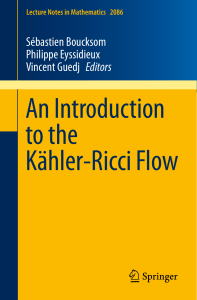A NOTE ON THE HOLOMORPHIC INVARIANTS OF TIAN–ZHU *
advertisement
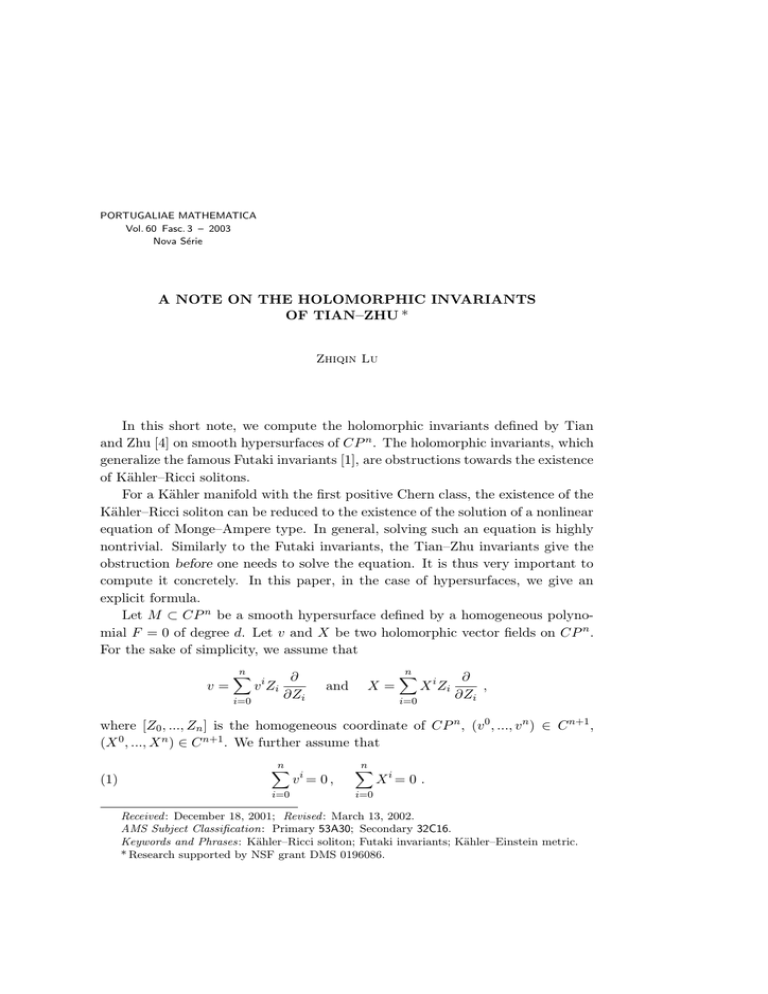
PORTUGALIAE MATHEMATICA Vol. 60 Fasc. 3 – 2003 Nova Série A NOTE ON THE HOLOMORPHIC INVARIANTS OF TIAN–ZHU * Zhiqin Lu In this short note, we compute the holomorphic invariants defined by Tian and Zhu [4] on smooth hypersurfaces of CP n . The holomorphic invariants, which generalize the famous Futaki invariants [1], are obstructions towards the existence of Kähler–Ricci solitons. For a Kähler manifold with the first positive Chern class, the existence of the Kähler–Ricci soliton can be reduced to the existence of the solution of a nonlinear equation of Monge–Ampere type. In general, solving such an equation is highly nontrivial. Similarly to the Futaki invariants, the Tian–Zhu invariants give the obstruction before one needs to solve the equation. It is thus very important to compute it concretely. In this paper, in the case of hypersurfaces, we give an explicit formula. Let M ⊂ CP n be a smooth hypersurface defined by a homogeneous polynomial F = 0 of degree d. Let v and X be two holomorphic vector fields on CP n . For the sake of simplicity, we assume that v= n X i=0 v i Zi ∂ ∂Zi and X= n X X i Zi i=0 ∂ , ∂Zi where [Z0 , ..., Zn ] is the homogeneous coordinate of CP n , (v 0 , ..., v n ) ∈ C n+1 , (X 0 , ..., X n ) ∈ C n+1 . We further assume that (1) n X i=0 i v = 0, n X Xi = 0 . i=0 Received : December 18, 2001; Revised : March 13, 2002. AMS Subject Classification: Primary 53A30; Secondary 32C16. Keywords and Phrases: Kähler–Ricci soliton; Futaki invariants; Kähler–Einstein metric. * Research supported by NSF grant DMS 0196086. 264 ZHIQIN LU If v and X are tangent vector fields of M , then there are complex numbers λ and κ such that (2) vF = κF , XF = λF . Let ω be the Kähler form of the Fubini–Study metric of CP n . Then (n − d + 1) ω restricts to a representative of the first Chern class c1 (M ) of M . Thus there is a smooth function ξ on M such that ´ ³ Ric (n − d + 1)ω|M − (n − d + 1)ω|M = ∂∂ξ . For fixed holomorphic vectors X and v, the holomorphic invariant defined by Tian–Zhu [4], in our context, is (3) FX (v) = (n − d + 1)n−1 Z M ´ ³ v ξ − (n − d + 1)θX e(n−d+1)θX ω n−1 , where θX is defined as √ −1 i(X)ω = ∂θX , 2π Z e(n−d+1)θX ω n−1 = d . (4) M The main property of the Tian–Zhu invariants is the following (cf. [4]): Theorem 1. Let FX (v) be the Tian–Zhu invariant. Then we have 1. If the Kähler-Ricci soliton exists, that is, we have Ric(ω) − ω = LX ω for some Kähler metric ω. Then FX (v) ≡ 0. 2. FX (v) is independent of the choice of the Kähler metric ω within the first Chern class. In this note, we give a “computable” expression of FX (v). Our main result is as follows: Theorem 2. Using the notations as above, defined the function (5) ϕ(X) = ∞ X n! (n − d + 1)k k=0 (n + k)! X X0α0 · · · Xnαn , α0 +···+αn =k A NOTE ON THE HOLOMORPHIC INVARIANTS OF TIAN–ZHU where α0 , ..., αn ∈ Zn+1 are nonnegative integers. Let (6) σ(X) = µ ¶ n d X λ(n − d + 1) ∂ϕ(X) + d ϕ(X) + . − Xi n n i=0 ∂X i Then the invariants defined by Tian–Zhu can be explicitly expressed as FX (v) = −(n − d + 1) (7) n−1 n X Ã ∂ log σ(X) d κ+ v ∂X i i=0 i ! . Corollary 1. The Futaki invariant for the hypersurface M is F (v) = −(n − d + 1)n−1 (n + 1) (d − 1) κ. n The rest of this note is devoted to the proof Theorem 2. We define θ̃X = (8) Then we have (9) λ0 |Z0 |2 + · · · + λn |Zn |2 . |Z0 |2 + · · · + |Zn |2 i(X)ω = ∂ θ̃X . By comparing the above equation with (4), we have (10) θX = θ̃X + cX for a constant cX . First, we have the following lemma Lemma 1. Z CP n e(n−d+1)θ̃X ω n = ϕ(X) , where ϕ(X) is defined in (5). Proof: This follows from the expansion e(n−d+1)θ̃X = ∞ X (n − d + 1)k k=0 and the elementary Calculus. k! k θ̃X , 265 266 ZHIQIN LU Lemma 2. Using the same notation as above, we have µ FX (v) = (n − d + 1)n−1 −κd − Z M (n − d + 1) θv e(n−d+1)θX ω n−1 ¶ . Proof: By [3, Theorem 4.1], we have div v + v(ξ) + (n − d + 1)θv = −κ , where θv is the function on CP n defined by θv = v0 |Z0 |2 + · · · + vn |Zn |2 , |Z0 |2 + · · · + |Zn |2 and κ is defined in (2). Then (3) becomes (11) FX (v) = (n − d + 1)n−1 · µZ ³ M ¶ ´ −κ − div v − (n−d+1)θv − (n−d+1) v(θX ) e(n−d+1)θX ω n−1 . We also have ³ ´ div (e(n−d+1)θX v) = e(n−d+1)θX div v + (n − d + 1) v(θX ) . (12) The lemma follows from (4), (11), (12) and the divergence theorem. The following key lemma transfers the integration on M to the integrations on CP n . Lemma 3. (n − d + 1) (13) Z M θv e(n−d+1)θX ω n−1 = d n X vi i=0 ∂ log σ , ∂X i where σ(X) is defined in (6). Proof: Let (14) η = log ³ |F |2 |Z0 |2 + · · · + |Zn |2 ´d . Then η is a smooth function on CP n outside M . We have the following identity: ³ ´ ∂ e(n−d+1)θX ∂η ∧ ω n−1 − (15) ³ ´ n−d+1 i(X) e(n−d+1)θX ∂η ∧ ω n = n = −e(n−d+1)θX ∂∂η ∧ ω n−1 − n−d+1 (n−d+1)θX e (λ − dθ̃X ) ω n . n A NOTE ON THE HOLOMORPHIC INVARIANTS OF TIAN–ZHU 267 Since on CP n , there are no (2n+1) forms, the left hand side of the above equation is the divergence of some vector field. Integrate the equation on both side and use the divergence theorem, we have (16) Z CP n e(n−d+1)θX ∂∂η ∧ ω n−1 = − n−d+1 n Z CP n (λ − dθ̃X ) e(n−d+1)θX ω n . By [2, page 388], in the sense of currents, we have (17) ∂∂η = [M ] − dω . Thus from (16), (18) Z e (n−d+1)θX ω n−1 M = µ λ(n−d+1) +d − n d(n−d+1) + n Z ¶Z CP n CP n e(n−d+1)θX ω n θ̃X e(n−d+1)θX ω n . From Lemma 1, we have (19) n X i=0 Xi ∂ϕ(X) = (n−d+1) ∂X i Z CP n θ̃X e(n−d+1)θ̃X ω n . By (10), (18) and (19) (20) Z e(n−d+1)θX ω n−1 = σ(X) ecX . M From the above equation, we have (21) (n − d + 1) Z M θv e(n−d+1)θX ω n−1 = n X i=0 On the other hand, from (20), we have (22) d = σ(X) ecX , by (4). Lemma 3 follows from (21) and (22). Theorem 2 follows from Lemma 2 and Lemma 3. vi ∂σ(X) cX e . ∂X i 268 ZHIQIN LU REFERENCES [1] Futaki, A. – An obstruction to the existence problem of positive Kähler Einstein metrics, Invent. Math., 73 (1983), 437–443. [2] Griffiths, P. and Harris, J. – Principle of Algebraic Geometry, John Wiley & Sons, 1978. [3] Lu, Z. – On the Futaki invariants of complete intersections, Duke Math. J., 100(2) (1999), 359–372. [4] Tian, G. and Zhu, X. – Uniqueness of Kähler–Ricci solitions, Acta Math., 184 (2000), 271–305. Zhiqin Lu, Department of Mathematics, University of California, Irvine, Irvine, CA 92697 – U.S.A. E-mail: zlu@math.uci.edu
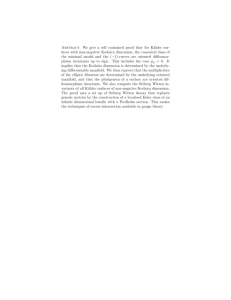



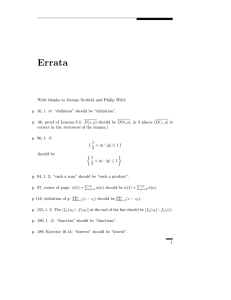


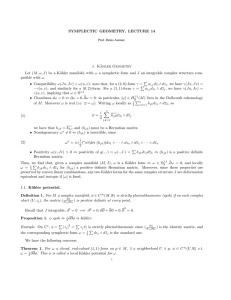
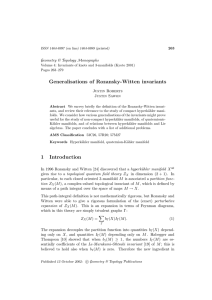
![N = 1 sigma models in AdS[subscript 4] Please share](http://s2.studylib.net/store/data/011563029_1-b752d0d0641ce62eeb98fd1863ff6dfa-300x300.png)
